A. Yes
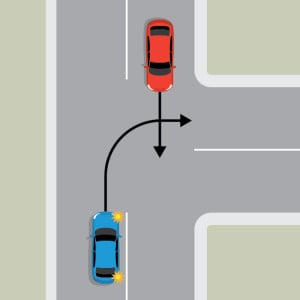 Does the driver of the blue car have to give way?
Does the driver of the blue car have to give way?
A. Yes
B. No
Let's look at a number of examples of giving way which can help you determine what to do at many kinds of intersections in New Zealand (and around the world). If you've been confused about the rules before, these simple examples will help you learn them easily.
The basic give way rules are:
In all examples, let's look at it from the point of view of you driving the blue car.
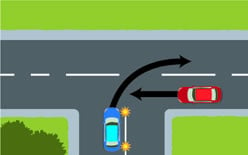
You are turning out of an uncontrolled intersection and must give way to the red car coming from the right. If this was a controlled intersection then you'd have to either stop at a stop sign or wait at a give way sign until it was safe to go.
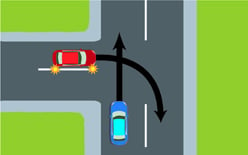
You are driving straight ahead in the blue car across the top of the T-intersection. The red car has to give way to you because it is turning right across your path.
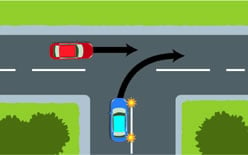
While the general rule is give way to the right at an uncontrolled intersection, that only applies at a crossroads. In this case, you are on the bottom of the T, and the red car has right of way as it is coming across the top of the T-junction. At a controlled intersection you would either be waiting at a stop sign or a give way sign.
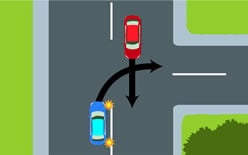
The red car is coming from straight ahead and you are turning right therefore you must let it past before you can turn.
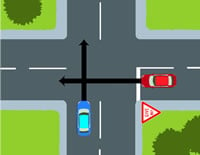
Even though the red car is on the right, it is waiting at a give way sign and you are passing straight through the junction. Therefore you have the right of way. The same would apply if it was waiting at a stop sign.
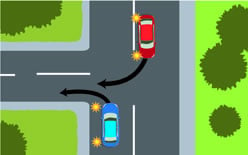
You are turning left and the red car is turning right and would have to cross your path. This used to be the rule in New Zealand until it was changed in 2012. Now, you have the right of way and can turn before the red car.
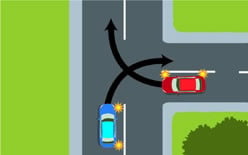
You are turning right and so is the red car. Which one gives way? The red car is on the bottom of the T-intersection (imagine rotating the picture 90 degrees clockwise). You are driving on the top of the T therefore you can go.
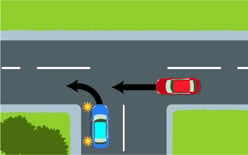
You are turning left and there's a red car coming from your right along the road. You have to wait because you are on the bottom of the T.
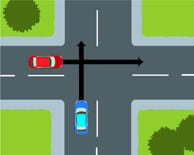
This is a tricky one. It's an uncontrolled intersection and both of you are travelling straight ahead. Who has to give way? The rules are that you give way to the right when there are no other controls like a stop sign, therefore the red car must stop and wait for you.
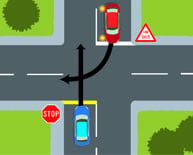
Remember our stop sign rule. At an uncontrolled intersection or one where you were both waiting at a give way sign, you would have right of way. However, you are waiting at a stop sign and that means that the red car has priority, even though it's turning across in front of you.
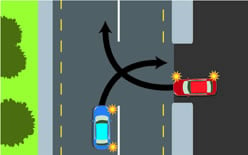
When both cars are turning right at an uncontrolled intersection (which includes many driveways and entrances to public car parks that don't have markings), you must give way to vehicles on the straight road (i.e. the top of the T). The blue car has right of way - the red car must wait for you to turn.
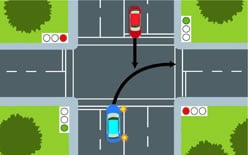
Even though you have a green light, so does the red car, and it is heading straight through the intersection while you want to turn, therefore you have to wait.
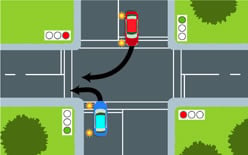
You both have a green light, but because you are turning left you can go first.
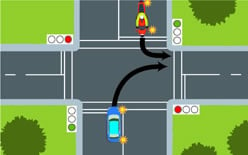
You both have a green light but the motorbike is turning left, therefore you must wait for it before you can turn.
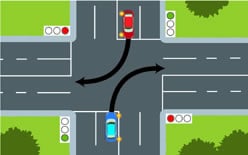
In this scenario neither car needs to cross each other's path. Both are on a green light. If this was an uncontrolled intersection this manoeuvre is actually safer when the cars pass behind one another rather than in front. This is because when passing like in the diagram, your vision up the road to the left is obscured.
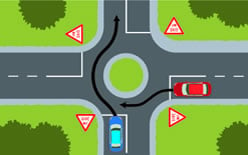
On a roundabout you always give way to the right, so you have to wait for the red car.
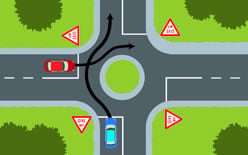
The red car must give way to you as you are coming from its right, passing straight through the roundabout.
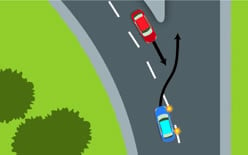
In this case you are deviating from the centre line, even though you want to drive straight ahead. The red car has right of way.
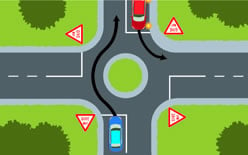
Both of you can complete your manoeuvre without interfering with each other's trajectories.
You are not permitted to queue across an intersection if there is a yellow hatched box painted on the road.
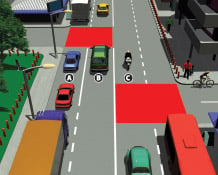
In the example above, the vehicle at C can cross the intersection because there is room the other side of the red box. The vehicle at B also has room, although not as much. The vehicle at A waits so that the intersection is not blocked.
Blocking an intersection is frustrating for other traffic as it can hold it up on the other side of the road. Drivers in queued traffic are likely to try to move out of the queue, which then means unnecessary lane changes which put them in danger.